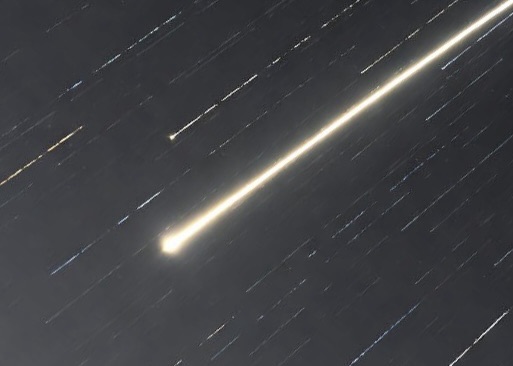A meteor, often called a shooting star, is the bright streak of light when a meteoroid enters Earth’s atmosphere, heating to incandescence in the mesosphere at 76-100 km altitudes. Meteoroids, small rocky or metallic bodies from comets or asteroids, create this glow through friction and ablation. Surviving fragments become meteorites, classified as chondrites, achondrites, iron, or stony-iron. Meteor showers, like the Perseids or Leonids, occur when Earth crosses debris streams, with meteors radiating from a point called the radiant. Bright fireballs or bolides can cause sonic booms or craters. Meteors originate from the Oort cloud or asteroid belt, entering at hypervelocity. Observation peaks during showers, with tools like aerogel capturing micrometeoroids. Studying meteors reveals solar system history, with finds like the Hoba meteorite or 2025’s Draconids and Orionids offering insights.
Long Version
A meteor, commonly known as a shooting star, is the visible streak of light produced when a meteoroid enters Earth’s atmosphere and is heated to incandescence by collisions with air molecules. This phenomenon occurs primarily in the mesosphere, at altitudes between 76 and 100 kilometers (47 to 62 miles). The term originates from the Greek word meteōros, meaning “high in the air,” reflecting its atmospheric nature. Meteors captivate observers worldwide, offering glimpses into the dynamic interactions between space and our planet, from fleeting trails to spectacular displays during meteor showers.
Definitions and Distinctions
Meteoroids are small rocky or metallic bodies in outer space, typically ranging from dust-sized particles to objects up to one meter in diameter. Those smaller than about 30 micrometers are classified as micrometeoroids or interplanetary dust, often referred to as dust particles. When a meteoroid survives its fiery passage through the atmosphere and reaches the ground, it becomes a meteorite. In contrast, a meteor is the luminous event itself, caused by friction and rapid compression of air ahead of the object, leading to ablation—the vaporization and shedding of material that creates the glowing trail.
Larger meteors that appear exceptionally bright are termed fireballs or bolides, with the latter sometimes used in geology to describe a massive impactor. The velocity of these objects upon entry averages around 20 kilometers per second but can reach up to 71 kilometers per second in retrograde orbits, where the meteoroid moves opposite to Earth’s direction, amplifying the relative speed. This hypervelocity entry can produce dramatic effects, including sonic booms and fragmentation.
Origins and Sources
Most meteoroids originate as fragments from larger celestial bodies, such as comets or asteroids. Comets, often hailing from the distant Oort cloud, release space debris as they approach the Sun, with ice sublimating and ejecting particles along their orbit. The perihelion—the closest point to the Sun, measured in astronomical units (AU)—intensifies this process, scattering material that can form streams. Asteroids from the asteroid belt between Mars and Jupiter contribute through collisions, producing debris that may enter Earth’s path.
Some meteoroids are ejected from planetary bodies like the Moon or Mars due to impacts, while others stem from the breakup of a parent body, such as a comet or asteroid. The escape velocity from the Sun, about 42 kilometers per second, sets an upper limit for solar system objects, but Earth’s orbital motion can boost relative speeds. Over time, gravitational perturbations from planets like Jupiter disperse these particles, leading to both organized streams and random sporadic meteors.
Atmospheric Entry and Phenomena
As a meteoroid plunges into Earth’s atmosphere at hypervelocity, it compresses the air, generating intense heat through friction and causing incandescence. This process begins in the mesosphere, where the object may fragment, producing a light curve—a record of brightness variations that reveals its composition and structure. Ablation strips away outer layers, creating a trail of ionized gas and meteoric smoke, fine particles that can linger in the upper atmosphere.
For larger objects, entry can result in explosions or airbursts, as seen in historical events. The absolute magnitude, a measure of intrinsic brightness, helps classify these; bright bolides often exceed -4 magnitude, visible even in daylight. If the meteoroid survives, its surface may show regmaglypts—thumbprint-like indentations from uneven ablation—or a fusion crust from melted material.
Meteor Showers
Meteor showers occur when Earth passes through a stream of debris from a comet or asteroid, resulting in multiple meteors appearing to radiate from a single point, known as the radiant. The zenithal hourly rate (ZHR) quantifies peak activity, representing the number of meteors visible under ideal conditions with the radiant at the zenith. Showers like the Perseids, peaking in mid-August with a ZHR of about 75, stem from Comet 109P/Swift-Tuttle, while the Leonids, known for storms every 33 years, originate from Comet 55P/Tempel-Tuttle and can exceed 1,000 meteors per hour during outbursts. The Phoenicids, linked to Comet 289P/Blanpain, are less frequent but can be intense in early December.
Sporadic meteors, unrelated to showers, arise from dispersed interplanetary dust. Showers are named after the constellation near their radiant, and their intensity varies with the stream’s age and density. Optimal viewing occurs after midnight, away from light pollution, when Earth faces its orbital direction.
Types and Classification of Meteorites
Meteorites are classified based on composition: chondrites, the most common, contain ancient chondrules—spherical inclusions—and represent primitive solar system material; achondrites lack chondrules and resemble igneous rocks from differentiated bodies; iron meteorites consist of nickel-iron alloys; and stony-iron meteorites, like pallasites, blend metallic and silicate components. These types provide clues to their origins, from asteroid cores to crustal fragments.
Tektites, glassy objects formed from terrestrial material melted by impacts, are not true meteorites but relate to them. Analysis of meteorites reveals organic compounds, water, and even nucleobases, suggesting roles in life’s origins.
Impacts and Craters
When a large meteoroid strikes as an impactor, it can form craters through hypervelocity collisions, excavating vast areas and sometimes vaporizing entirely. Earth’s geological processes erode these features, but examples like Barringer Crater in Arizona, formed by an iron meteorite, endure. Cryptoexplosion structures, once puzzling, are now recognized as impact-related. Rare large events, like the Tunguska airburst, cause widespread devastation without craters.
Observation and Detection
Meteors are best observed during showers, with tools like radio detection for daytime events. Scientific collection uses aerogel, a low-density material that captures micrometeoroids, preserving delicate tracks from their passage. Networks like NASA’s fireball monitoring and the Cameras for Allsky Meteor Surveillance (CAMS) track entries, aiding in orbit calculations and threat assessments.
Scientific Study and Collection
Studying meteors and meteorites unlocks solar system history. Spectral analysis during entry infers composition, while meteorite examination dates materials to 4.55 billion years old. Finds in Antarctica and deserts yield pristine samples, with witnessed falls providing orbital data. Advances include detecting organic molecules, supporting theories of extraterrestrial contributions to Earth’s biochemistry.
Notable Meteors and Meteorites
Historical events include the 1833 Leonid storm, with over 100,000 meteors per hour, and the 2013 Chelyabinsk bolide, injuring over 1,000. Famous meteorites like the 60-tonne Hoba iron in Namibia showcase regmaglypts, while Martian and lunar samples offer planetary insights.
Recent Events
In 2025, notable meteor activity includes the Draconid shower peaking October 8 with up to 10 meteors per hour from Comet 21P/Giacobini-Zinner, and the Orionids peaking October 21 under dark skies. A low-mass meteorite fall occurred February 21 near the Maine-Canada border. CAMS detected an outburst from a new shower near gamma Horologii in late September-early October. Upcoming showers like the Lyrids (April 22) and Perseids (August 12) promise strong displays.
Hashtags For Social Media
#meteor #shootingstar #meteorite #meteorshower #space #astronomy #stargazing #nightsky #cosmos #universe #perseids #leonids #draconids #orionids #fireball #bolide #stargazers #skywatching #astrophotography #spaceexploration #comets #asteroids #mesosphere #hypervelocity #crater #tektites #chondrites #starrynight #spacefacts #astronomicalevents
Related Questions, Words, Phrases
what is a meteor | how does a shooting star form | what causes a meteor to glow | why do meteors streak across the sky | what is the difference between a meteor and a meteorite | what are meteoroids made of | how fast do meteors travel | where do meteors come from | what is a meteor shower | when is the best time to see a meteor shower | what are the perseids | how high up do meteors burn | what is the mesosphere’s role in meteors | why do some meteors explode | what is a fireball meteor | what is a bolide | how are meteorites classified | what are chondrites | what causes craters on earth | how do comets create meteors | what is the oort cloud | how does ablation affect meteors | what is meteoric smoke | how to observe meteors | what is the radiant in a meteor shower | what is the zenithal hourly rate | how do asteroids contribute to meteors | what are tektites | how do scientists study meteorites | what was the chelyabinsk meteor | when do the leonids peak | what are regmaglypts on meteorites | how does hypervelocity impact meteors | what are the draconids | why do meteors have different brightness levels






